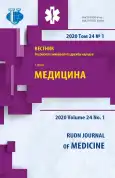Analysis of the vascular abnormalities of the patients with ankle joint mild osteoarthritis
- Authors: Mombekov A.O.1, Karpovich N.I.1, Dogotar O.A.1, Dergunov A.V.2, Zagorodnyi N.B.1
-
Affiliations:
- Peoples’ Friendship University of Russia (RUDN University)
- Military Medical Academy named after S.M. Kirov
- Issue: Vol 24, No 1 (2020)
- Pages: 26-37
- Section: TRAUMATOLOGY
- URL: https://journal-vniispk.ru/2313-0245/article/view/319579
- DOI: https://doi.org/10.22363/2313-0245-2020-24-1-26-37
- ID: 319579
Cite item
Full Text
Abstract
The vascular factor is one of the leading pathogenesis factors in the formation of ankle joint osteoarthritis. Dystrophic and sclerotic changes in the joint tissues develop as a result of blood flow decrease. These mechanisms understanding will allow to plan treatment and rehabilitation measures, as well as predict and prevent complications. The purpose of the work is to study hemodynamic parameters in the main lower leg arteries of the in patients in follow-up period of mild ankle joint osteoarthritis. Two groups of patients were examined. The first group - 82 patients with mild ankle joint osteoarthritis in the follow-up period (10 years) and the second group - control (healthy) group of 58 people without ankle joint osteoarthritis. Duplex scan of the main lower leg arteries was performed to all the patients. The state of arteries and hemodynamic parameters were evaluated. Excell and STATISTICA 10.0 programs were used for statistical data processing. In patients with follow-up of mild ankle joint osteoarthritis, the diameter of the arteries did not differ from the control group. In patients with mild ankle joint osteoarthritis the thickness of the Intima-media complex in the lower leg arteries and walls pulsation were significantly higher than those in patients of the control group (p <0.05). Analysis of hemodynamic parameters in patients with ankle joint osteoarthritis revealed an increase in the linear velocity of blood flow with a further tendency to normalization and even decrease in the follow-up compared with the control group. Signs of perfusion difficulty that accompanied the development of high blood pressure syndrome in the lower leg arteries were observed in 122 (67.0%) patients, and the signs of perfusion difficulty were bilateral in most of the cases (86.9%). Stenosis, deformation and arteries tortuosity were noted in 22% of patients with ankle joint osteoarthritis. Thus, mild ankle joint osteoarthritis is accompanied by blood flow changes in the form of inadequate perfusion and high-pressure syndrome in the lower leg arteries, which can cause secondary injuries and requires higher attention when selecting treatment and rehabilitation actions.
About the authors
A. O. Mombekov
Peoples’ Friendship University of Russia (RUDN University)
Author for correspondence.
Email: galen7@yandex.ru
Moscow, Russian Federation
N. I. Karpovich
Peoples’ Friendship University of Russia (RUDN University)
Email: galen7@yandex.ru
Moscow, Russian Federation
O. A. Dogotar
Peoples’ Friendship University of Russia (RUDN University)
Email: galen7@yandex.ru
Moscow, Russian Federation
A. V. Dergunov
Military Medical Academy named after S.M. Kirov
Email: galen7@yandex.ru
Saint-Petersburg, Russian Federation
N. B. Zagorodnyi
Peoples’ Friendship University of Russia (RUDN University)
Email: galen7@yandex.ru
Moscow, Russian Federation
References
- Borovikova T.A., Myakotnyh V.S. The current state of the problem of atherosclerosis (review). Advances in gerontology (St. Petersburg). 2000;(4):112—7.
- Krupatkin A.I. Functional studies of peripheral blood circulation and tissue microcirculation in traumatology and orthopedics: opportunities and prospects. Bulletin of Traumatology and Orthopedics. N.N. Priorova. 2000;(1):66—9.
- Barg A., Pagenstert G.I, Hügle T., Gloyer M., Wiewiorski M., Henninger H.B., Valderrabano V. Ankle Osteoarthritis: Etiology, Diagnostics, and Classification. Foot Ankle Clin. Sep 2013;18(3):411—26.
- Cherkess-Zade D.I., Kamenev Yu.F. Foot surgery. Ed. 2nd, re-slave. and add. M.: Medicine, 2002. 328 p.
- Ardashev I.P., Afonin E.A., Vlasova I.V., Voronkin R.G., Kazanin K.S. Diagnosis of vascular disorders in foot bones fractures. Bulletin of new medical technologies. 2010; 17(1):159—62.
- Pisarev V.V., Lvov S.E., Vasin I.V., Tikhomolova E.V. Regional hemodynamics in various types of surgical treatment of diaphyseal fractures of the lower leg bones. Traumatology and Orthopedics of Russia. 2012;1:36—42.
- Ewalefo S.O., Dombrowski M., Hirase T., Rocha J.L., Weaver M. Kline A. at all. Management of Posttraumatic Ankle Arthritis: Literature Review. Curr Rev Musculoskelet Med. Dec 2018;11(4);546—57.
- Udartsev E.Yu., Chantsev A.V., Raspopova E.A. A differentiated pathogenetic approach to the selection of rehabilitation means for patients with post-traumatic knee and ankle joints osteoarthritis. Traumatology and Orthopedics of Russia. 2009;3: 20—7.
- Lelyuk V.G., Lelyuk S.E. Ultrasound angiology. M.: Real time. 2003. 336 p.
- Shevtsov V.I., Bunov B.C Primary hemodynamic changes during tunnel diaphysis tunneling. Angiology and Vascular Surgery. 2005;11(1):14—8.
- Vlachopoulos Charalambos, O’Rourke Michael, Wilmer W. Nichols. McDonald’s blood flow in arteries: Theoretical, Experimental and Clinical Principles. — 6-th ed. London. Arnold. 2011. 768 p.
- Rogoznikova K.A. Osteoarthrosis. How to maintain joint mobility. SPb. 2006. 248 с.
- Paterson K.L., Gates G. Clinical Assessment and Management of Foot and Ankle Osteoarthritis: A Review of Current Evidence and Focus on Pharmacological Treatment. Drugs Aging. Mar 2019;36(3):203—11.
- Povoroznyuk V.V. Osteoarthrosis: modern principles of treatment. Health of Ukraine.2003;(11):45—8.
- Perrot S., Menkes Ch.J. Non-pharmacological approaches to pain in osteoarthritis. Drugs. 1996; 52. Suppl. 3. P. 2126.
- Lee J.H. et al. Carbon dioxide reactivity, pressure autoregulation and metabolic suppression reactivity after head injury: a transcranial Doppler study. J. Neurosurg. 2001; 95(2):222—32.
Supplementary files









